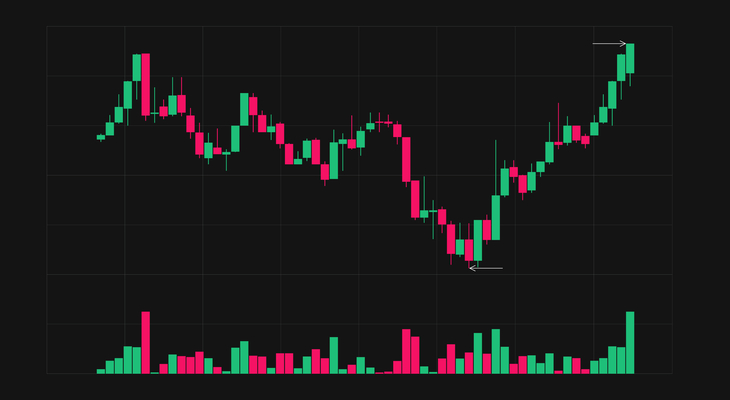20 Expert Tips for Day Trading
Discover 20 practical tips for day trading to improve your strategy, reduce risks, and make more innovative moves in fast-paced markets.

Day trading is a thrilling world, promising quick returns and the freedom of being your boss. But it can also be a wild ride, with intense highs and devastating lows. Smart Money Trading is crucial here, especially for beginners looking to maximize their trading potential with the capital they have available. This guide will help you navigate the challenges of day trading and offer actionable tips to optimize your investment returns.
For those eager to jumpstart their journey, Aqua Funded’s funded trading program offers a proven way to boost your capital and hone your skills, increasing your chances of success in the fast-paced world of day trading.
Benefits of Day Trading

1. Quick Profits: Seize the Moment
Day trading offers the allure of swift profits. Unlike long-term strategies that span months or years, day traders make moves within hours or even minutes, capitalizing on the price fluctuations that occur with rapid shifts. A study from the University of California reveals that only about 1% of day traders consistently succeed, highlighting the importance of skill. Volatile markets present significant swings, giving ample room for profit, but you'll need quick decision-making and a solid game plan to cash in.
2. Flexibility and Freedom: Trade from Anywhere
Day trading offers the flexibility to work from anywhere with an internet connection, which is a dream for those seeking financial freedom. Unlike a traditional 9-to-5 job, you set your schedule and trading hours. Keep in mind, though, that success requires discipline, a structured routine, and constant market monitoring.
3. Thriving on Liquidity and Volatility: Embrace the Chaos
Day trading is most effective in liquid and volatile markets. Liquidity allows quick buying and selling without significant price impacts. Stocks like Apple and Tesla, with high trading volumes, are popular choices. Volatility creates the price swings that traders profit from, although it also ramps up risk. Successfully navigating this requires a keen eye for trends and decisive action.
4. Leverage for Amplified Returns: Boost Your Gains
Many day traders use leverage to control larger positions with less capital, significantly amplifying potential gains. For instance, a 4:1 leverage ratio means a trader with $10,000 can control $40,000 worth of assets. While this boosts profit potential, it also heightens risk. Effective risk management, such as stop-loss orders, is crucial for avoiding significant losses.
5. A Wide Range of Trading Opportunities: Diversify Your Options
Day traders can access various financial markets, including stocks, ETFs, forex, and futures and options. Stocks are popular for momentum and breakout strategies, while ETFs offer diversification with less risk. Forex, with its high liquidity and 24-hour trading, appeals to many traders. Futures and options provide leverage and hedging opportunities. This diversity enables traders to adapt to different market conditions and capitalize on their strengths.
6. Profiting in Any Market Condition: Stay on Top
Unlike long-term investors who rely on rising markets, day traders can profit in both bull and bear markets. Strategies like short selling let traders make money even when prices drop. For instance, a trader can short-sell a stock expected to fall after disappointing earnings and profit from the decline. This adaptability makes day trading a versatile approach in various economic conditions.
7. Lower Exposure to Overnight Risks: Sleep Easy
Holding stocks overnight exposes investors to after-hours market events, which can lead to unexpected losses. Since day traders close their positions by the end of the day, they avoid these overnight risks. This approach offers peace of mind in a fast-paced trading world.
8. Continuous Learning and Skill Growth: Keep Growing
Day trading requires constant learning, helping traders develop valuable market skills. Mastering technical analysis, market indicators, and trading psychology enhances decision-making and financial literacy, ultimately leading to informed and effective trading. This continuous growth is essential in an ever-evolving market.
9. Potential for Financial Independence: Become Your Boss
For skilled traders, day trading can become a full-time career, offering the potential for financial independence and autonomy. While it demands dedication and discipline, those who refine their strategies and manage risk effectively can turn trading into a sustainable source of income. It's a challenging path, but the rewards are worth it.
Key Features of Day Trading

1. Short-term Frenzy: Trading Like a Pro
Day trading is all about short-term strategies. Traders make multiple buys and sells in a single day. This fast-paced approach is designed to capitalize on small price changes. Such a strategy requires traders to spend a considerable amount of time closely monitoring the markets. It's a high-energy commitment for those seeking quick wins.
2. Technical Tactics: The Tools of the Trade
Day traders rely heavily on technical analysis. They study market trends and use charts, patterns, and indicators to make informed decisions. This method helps traders predict where the market is headed. It's all about using data to make informed decisions in real-time.
3. Leveraging Success: Boosting Your Buying Power
In day trading, using leverage is a common practice. It allows traders to control larger positions with less capital. This means they can increase their market exposure and potential profits. However, remember that leverage also amplifies risk, so it's crucial to use it wisely.
Explore our funded trading program at AquaFunded. You can turn your trading skills into profits without risking your own money. Get access to up to $400K accounts with flexible conditions, like no time limits and easy profit targets. Join over 42,000 traders who have earned more than $2.9 million in rewards. Start trading today with our instant funding options and keep up to 100% of what you earn.
Related Reading
- How Much Money Do You Need to Start Trading
- How Long Does It Take to Learn Trading
- What Challenges Do Traders Face?
- Futures vs Stocks Trading
- Why is Trading So Hard
- How to Swing Trade
- How to Multiply Your Money
- How to Start Trading With No Money
20 Tips for Day Trading

1. Turn Your Skills into Profits with AquaFunded
Looking to maximize your trading potential without the financial risk? AquaFunded is your go-to platform. It allows you to use trading accounts of up to $ 400,000, offering flexible trading conditions, easy-to-reach profit targets, and a profit split of up to 100%. Join a community of over 42,000 traders who’ve already claimed more than $2.9 million in rewards, with speedy payouts in just 48 hours. Whether you seek instant funding or prefer to prove your skills through customizable challenges, AquaFunded lets you keep what you earn.
2. Start Small, Scale Up
Don’t dive in headfirst. Begin with smaller trades to avoid financial disasters early on. Trading with a modest amount lets you learn market behavior, build discipline, and boost your confidence. Once you see consistent positive results, you can gradually increase your positions while controlling risk.
3. Automate with Stop-Loss and Take-Profit Orders
Stop-loss and take-profit orders help manage your trades by closing them at predetermined levels, minimizing losses, and securing gains. These tools are crucial in fast-moving markets where hesitation can lead to significant losses. Using them enforces discipline and protects you from emotional decisions, such as holding onto losing trades or exiting winners too soon.
4. Hone Your Skills with Paper Trading
Paper trading is a must for beginners. It involves using a demo account to practice trading in real-time without risking money. This builds experience, confidence, and understanding of order execution and strategy implementation. Most brokers, such as AvaTrade, offer demo accounts for this exact purpose.
5. Choose Liquid and Volatile Stocks
Focus on stocks with high liquidity and volatility. Liquidity ensures quick entry and exit without significant price fluctuations, while volatility offers potential for intraday movement and profit opportunities. Look for stocks with high daily trading volume and significant price ranges. Avoid illiquid or low-volume stocks that can trap you in positions.
6. Prepare with Pre-Market Scanning
Successful traders don’t wing it. Use pre-market screeners to identify stocks that meet your criteria, such as gapping up, unusual volume, or breaking news. Mark key support and resistance levels, define your watchlist, and prepare your strategy in advance to optimize your trading. Being ready before the market opens boosts your confidence and execution speed.
7. Use Technical Indicators Wisely
Indicators like moving averages, RSI, and MACD help identify potential entry and exit points. However, don’t rely solely on them. Use indicators in conjunction with price action, volume, and market context to make informed decisions.
8. Master Level II and Order Flow
Level II data shows real-time bid and ask prices along with market depth. Combined with order flow, it helps you understand momentum and predict short-term movements. Mastering this can give you a significant edge, especially if you’re into scalping.
9. Trade During Optimal Hours
The first and last hours of trading usually have the highest volatility and volume, offering the best opportunities. Avoid trading during slow midday periods unless you have a specific edge. For beginners, trading during peak times when patterns are reliable is advisable.
10. Eliminate Distractions
Day trading needs your full attention. Avoid distractions like social media or multitasking. Set up a dedicated workspace with multiple screens, fast internet, and all trading tools ready. Even a brief distraction can lead to missed opportunities or holding onto bad trades too long.
11. Control Your Emotions
Fear, greed, overconfidence, and frustration can sabotage your trades. One emotional mistake can wipe out several winning trades. Stay calm, follow your plan, and accept that losses are part of trading. Emotional control separates professionals from amateurs.
12. Keep a Detailed Trading Journal
Track every trade with details like entry and exit points, indicators used, size, and emotional state. Regularly review your journal to identify patterns in winning and losing trades. This helps refine your strategy, correct mistakes, and understand your trading psychology.
13. Stay Flexible and Adapt
Markets are dynamic. A strategy that works in one condition may fail in another. Be prepared to adapt your approach, stop trading when setups aren’t present, and adjust your expectations accordingly. Flexibility prevents forcing trades and unnecessary losses.
14. Know the Regulatory Rules
In the U.S., the Pattern Day Trader rule requires a $25,000 minimum balance to make more than four day trades in five days. Ignorance of such laws can result in account restrictions. Understand your broker’s regulations to avoid penalties.
15. Be Careful with Leverage and Margin
Using borrowed money can amplify gains and losses. Many traders go broke by overleveraging. Always calculate your risk before entering a trade. Use margin only when you’re consistently profitable and fully understand the risks involved.
16. Limit Trades and Your Watchlist
Avoid spreading yourself too thin. Stick to 1–3 stocks per day to monitor price action effectively. Narrow your watchlist to stocks that align with your strategy, enabling you to become more familiar with specific behaviors and patterns.
17. Ignore "Hot Tips" and Noise
Don’t fall for social media hype or chatroom tips. This often leads to impulsive trades based on someone else's opinion. Stick to your trading plan, conduct thorough research, and approach trading as a business, not a guessing game.
18. Use Proper Position Sizing
Position sizing is key to managing risk. Determine how much you’re willing to lose per trade, usually 0.5–1% of your account. This ensures that even a series of losses doesn’t significantly impact your capital.
19. Conduct Daily Reviews
After the market closes, take time to analyze your performance. Did you follow your rules? Did emotions influence your actions? Reviewing your trading day helps catch bad habits early and reinforces good discipline.
20. Keep Learning
Markets constantly evolve. Keep reading, take courses, watch expert traders, and analyze your performance. Study trading psychology, patterns, and risk management. Successful traders are lifelong learners who continuously improve their edge.
Related Reading
- What Happens if You Blow a Funded Account
- How to Become a Professional Trader
- Best Market to Trade for Beginners
- Common Trading Mistakes
- Margin vs Leverage
- How Much Can You Make Day Trading With 100k
- Scalping Trading Strategy
- Margin vs Leverage
- Day Trading vs Options
- Best Time Frame for Day Trading
10 Best Courses to Learn Day Trading
1. AquaFunded: Maximize Your Trading Skills Without Risking Your Capital

AquaFunded is where your trading skills turn into tangible rewards. Forget risking your own money, AquaFunded provides access to accounts up to $400K with the most flexible conditions around. We're talking no time limits and profit targets you can hit, plus up to a full profit split. Join over 42,000 traders who have already bagged more than $2.9 million, all with a 48-hour payment guarantee. Explore now with instant funding or show your chops through customizable challenge paths, keeping up to 100% of your gains.
2. Yale’s Financial Markets Course: The Academic Foundation for Trading

Led by Nobel laureate Robert Shiller, the Financial Markets course on Coursera offers crucial insights into how financial markets function. Shiller's expertise in market bubbles and behavioral finance gives you a unique lens into market psychology. You'll explore how various markets operate, the importance of risk diversification, and how irrational behaviors impact markets. This is your opportunity to understand the role of institutions and regulations in maintaining market stability.
3. Warrior Trading: The Most Comprehensive Day Trading Resource

Warrior Trading’s Strategies and Scaling course stands out as the most complete day trading education around. It serves up over 100 hours of video lectures, live streams, interactive tools, and a supportive community. You’ll gain access to a treasure trove of resources that cover everything from day trading basics to advanced strategies for scaling your efforts. Plus, community feedback ensures you’re always learning from others who share your passion.
4. Udemy’s Complete Foundation Stock Trading Course: Practical Trading Skills for Beginners

If you're looking to build practical trading skills, The Complete Foundation Stock Trading Course is your roadmap. Taught by seasoned trader Mohsen Hassan, this course emphasizes the “how” of trading execution and technical analysis. You’ll dive into the mechanics of stock markets, master candlestick patterns, and develop risk and money management strategies. Plus, you'll learn to execute different order types effectively and even short-sell to profit in declining markets.
5. Udemy’s Stock Market from Scratch: The Best Beginner Course

Udemy’s Stock Market from Scratch for Complete Beginners is the ultimate starting point for those new to trading. It’s crafted with novices in mind and assumes no prior knowledge. You’ll learn the basics of stock markets, technical analysis, and risk management in a way that’s easy to understand. Plus, Udemy courses are often discounted, so you’re getting great value for your investment.
6. Udemy’s Advanced Stock Trading Course + Strategies: Level Up Your Trading Skills

Building on the foundation course, Mohsen Hassan’s advanced offering delves into professional trading mechanics. You’ll analyze market microstructure, evaluate company fundamentals, and understand macroeconomic factors. The course encompasses two distinct trading strategies and a structured plan tailored to various market conditions. While some sections lean more towards theory, the real-time explanations and whiteboard illustrations break down complex concepts into manageable pieces.
7. Charles Schwab: A Wealth of Free Trading and Investing Resources

Charles Schwab offers a massive collection of free trading and investing education, accessible to everyone, not just clients. It’s a great place to learn about stocks, bonds, options, and futures. The content is high-quality, constantly updated, and covers a wide range of topics, from basics to advanced strategies.
8. Humbled Trader: The Best Free YouTube Course for Day Trading

Shay, also known as “Humbled Trader,” has built a hugely popular YouTube channel focused on day trading education. Her balanced, transparent approach acknowledges both the potential and pitfalls of day trading. The channel features educational content, live trade recaps, and practical guidance for developing discipline. Shay’s teaching style is accessible and engaging, making complex topics easy to understand.
9. London Academy of Trading: Master the Trader's Mindset

London Academy of Trading’s Trading Psychology Workshop is the top choice for educating the trader’s mindset. It combines fundamental and technical aspects of trading with psychology, helping you manage the underestimated aspect of trading your mind. The course offers superb value with high-quality content and a high-impact learning environment.
10. Udemy’s Forex Trading for Beginners: Learn the Essentials of Forex Trading

Udemy’s Forex Trading for Beginners course stands out with its hands-on approach, showing actual live forex trades. Instructor Kirill Eremenko breaks down complex concepts into accessible explanations, making it perfect for complete beginners. You’ll learn forex fundamentals, set up a trading environment, and analyze trades using fundamental, technical, and sentiment approaches. The course also covers proper risk management techniques to protect your trading capital.
Join Our Funded Trading Program Today - Trade with our Capital and Keep up to 100% of the Profit.
So, you're ready to elevate your trading game, but don't want to risk your capital. AquaFunded is the answer. This innovative platform enables you to trade accounts of up to $400,000 without the stress of using your funds. What sets AquaFunded apart? Flexible trading conditions. We're talking no time limits, achievable profit targets, and up to a 100% profit split. You read that right, keep everything you earn. Over 42,000 traders worldwide have already reaped the rewards, sharing in over $2.9 million, with the security of a 48-hour payment guarantee. Whether you want instant funding or prefer to prove your skills through customizable challenges, AquaFunded has you covered.
Day Trading Tips: Elevate Your Strategy
Day trading requires skill and a strategic approach. To thrive, plan your trades meticulously. Understand market trends, identify strong setups, and set realistic goals. Keep your emotions in check. Fear and greed can cloud your judgment and derail your strategy. Stay disciplined and stick to your plan. Risk management is key. Use stop-loss orders to protect your capital and never risk more than you can afford to lose. Diversify your trades to spread risk and increase your chances of success. Finally, stay informed. Follow market news and economic events that can impact your trades. Adapt your strategy as needed to stay ahead of the game.
Join our community of traders today and start earning with confidence.
Related Reading
- Why Do Most Day Traders Fail
- Is Day Trading Profitable
- How to Take Profits in Trading
- Fair Value Gap Trading
- Best Time of Day to Trade Stocks
- How to Make Money Online Trading
- Prop Firms With No Time Limit
- Different Stock Trading Strategies
- Swing Trading Prop Firms
- Best Technical Indicators for Day Trading


